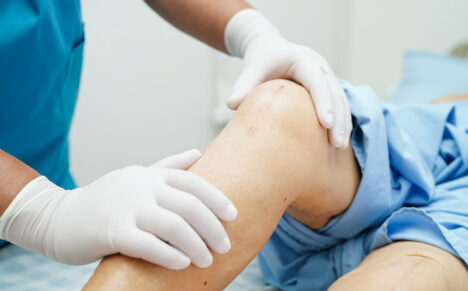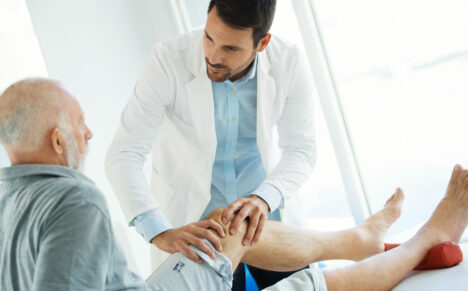Who’s up for a game of pickleball? Pickleball is quickly becoming one of the most popular recreational sports in the US, especially with the 55 and older crowd. If you’ve never heard of it, it’s a game that’s kind of a cross between tennis, racket ball and ping pong. The net is lower, and the court is smaller than in tennis, but it’s also played on a hard court. It’s a great way to get some exercise, to socialize and to meet new friends. However, as with any sport, injuries can occur. Because injuries can be more significant and debilitating as we get older, it is very important to take steps to play the game safely. Once you’ve done your homework and gotten yourself ready, you can go have a “ball” with your friends on the courts.
Potential Injuries While Playing Pickleball
All sports have risks and pickleball is no exception. Potential injuries while playing this exciting game are similar to those in tennis or racket ball. Any activity that has you stopping short, changing direction quickly and/or pivoting puts your knees at risk. Common injuries include sprains, and meniscal or ligament tears. These same movements may also cause injuries to your lower legs, resulting in ankle sprains or Achilles tendon strains. Additionally, Plantar fasciitis which is inflammation of the tissue in the heel can be caused by repetitive pounding on the court.
Upper extremities are also a point of concern when you play any racket sport. Falls can result in fractures or sprains of the wrist or elbow. Shoulders are also at risk with a fall, and although not as common as in tennis, rotator cuff injuries can also occur. Another type of injury that may not be immediately apparent but can happen over time is tendonitis of the elbow (tennis elbow) or wrist. These types of injuries are typically caused by repetitive movements as in swinging a racket again and again.
Strains are also a concern while playing pickleball. The bending, pivoting and stopping short again can stress the muscles involved, possibly even resulting in minor muscle tears. Areas at risk are primarily in the legs—hamstrings, quadriceps, hip flexors and calf muscles. However, a lower back strain is also a concern as your twist and bend while going for the ball.
How to Avoid Injuries
1. Regular Exercise
It’s great to get out there and have fun but pickleball shouldn’t be your only physical activity. Protecting the vulnerable areas of your body—back, knees, shoulders—by performing a regular exercise routine can keep you healthy on and off the court. Strengthening exercise of the legs, especially your quadriceps, hamstrings and calf muscles will support your knees and help protect them from injury. Keeping your upper body strong will reduce your risk of shoulder injury. Core exercise, focusing on strengthening your abdominal muscles, will reduce the strain on your lower back while you are playing.
2. Warm Up, Stretch and Rest
Before any physical activity it’s important to warm up and stretch. Take a brisk walk for 10 to 15 minutes. If you run, a light jog would work. Once your muscles are warm, stretch them so that a tight muscle doesn’t end up a strained muscle, or worse, an injured joint. Focus on stretching the muscles of your lower body that will get used the most—hamstrings, hip flexors, quadriceps, glutes. This will not only help your legs, hips and knees, but also your back. Don’t forget to stretch your shoulders, and warm up your elbows and wrists. And finally, don’t overdue. Listen to your body and rest when you need to. Sore muscles after strenuous play is normal, but pain is not. And if you’re experiencing elbow, wrist or heel pain and achiness, this may be a sign that you’re overdoing it.
3. Hydrate
It goes without saying that pickleball is played outdoors when the weather is nice. That usually means sunshine and higher temperatures. It is very important to hydrate not only while you’re playing, but before you go. Unless there are medical reasons for you to avoid fluids, try to drink 6 to 8 glasses of water every day. While you are playing, drinks with electrolytes will replenish some of the salts you lose while you are exerting yourself. Dehydration can lead to a multitude of problems, especially as you get older, not the least of which is dizziness which can then lead to falls and injury. If you feel lightheaded while you are playing, find some shade, drink some fluids and take a break. Winning is never as important as your health.
4. Protect Your Eyes
Playing any racket sport has the potential of you getting hit with the ball. While that may not cause much damage on your arm or leg, getting hit in the eye is concerning. Injuries can range from small cuts and bruises to interocular bleeding and retinal detachment. Some of these injuries can result in vision loss. The American College of Ophthalmology estimates that most eye injuries during sports are preventable. Using protective eyewear, particularly with polycarbonate lenses, is recommended for all racket sports. It is also important to inspect your eyewear regularly because cracked lenses do not offer full protection.
5. Wear the Right Shoes
Many of the leg injuries such as ankle sprains or meniscal tears can be prevented with the right footwear. Ankle sprains can be caused by rolling the ankle. Knee ligament or meniscal tears often occur with stopping short or changing direction quickly. Wearing the right shoes that offer support but have some give in the sole can help prevent these injuries. Court shoes are probably the most important equipment you will purchase for your pickleball career. Running shoes are a recipe for disaster. So, protect your lower extremities by stepping on the court with the right shoes—every time.
What if an Injury Occurs?
Unfortunately, sometimes injuries just can’t be prevented. If you do get hurt, the type of injury you experience will determine your next move. If you get hit in the eye with the ball and experience pain or loss of vision, emergency care is warranted. Falls where you suspect a fracture should also be evaluated by a healthcare provider right away. If x-rays indicate you have a fracture, you will need to see an orthopedic surgeon, who specializes in the treatment of bones, joints, muscle, ligaments and tendons. If your hurt your knee and you feel a pop, your knee giving way, or experience severe swelling and pain, especially if you can’t resume playing, you should see an orthopedic surgeon right away. However, if it is a minor muscle or joint injury, your first conservative treatment should be RICE—rest, ice, compression and elevation. This along with some over-the-counter pain relievers should get you going in a few days to a week. If your pain does not improve, or if you feel clicking or persistent swelling, you should be evaluated by an orthopedic surgeon. A shoulder injury that results in pain and a persistent inability to raise your arm above shoulder-height should also be evaluated by a healthcare provider and may need a referral to orthopedics. Finally, chronic aching, shooting or radiating pain from the wrist, elbow or heel could indicate an overuse injury. Your first advice is rest and ice. Tennis wrist and elbow, or plantar fasciitis typically improves with targeted stretching exercises.
Staying physically active is very good for your health and pickleball is a fun way to do it. Just remember to protect yourself, and if you suffer an injury, get prompt and appropriate medical attention. Dr. Brett Gilbert and his friendly team are here to answer your questions and evaluate any sports injuries or any other problems with your bones or joints. Call the offices of Dr. Brett Gilbert at (919) 788-8797 or you can request an appointment with Dr. Gilbert using our appointment request form, or you can self-schedule your appointment here.




